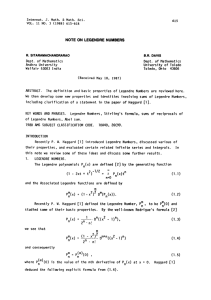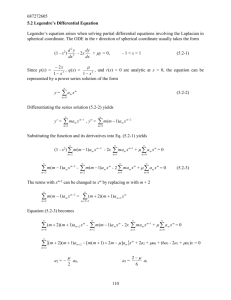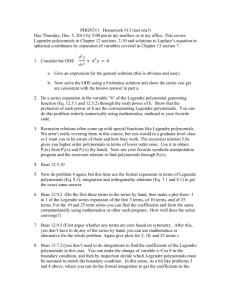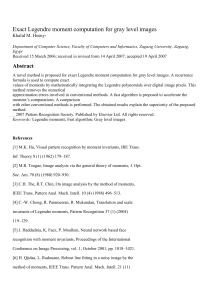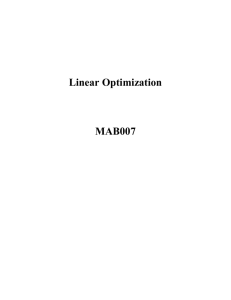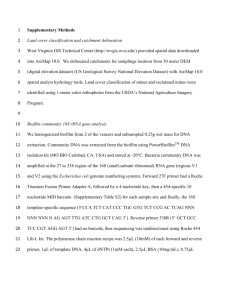Document 10437657
advertisement
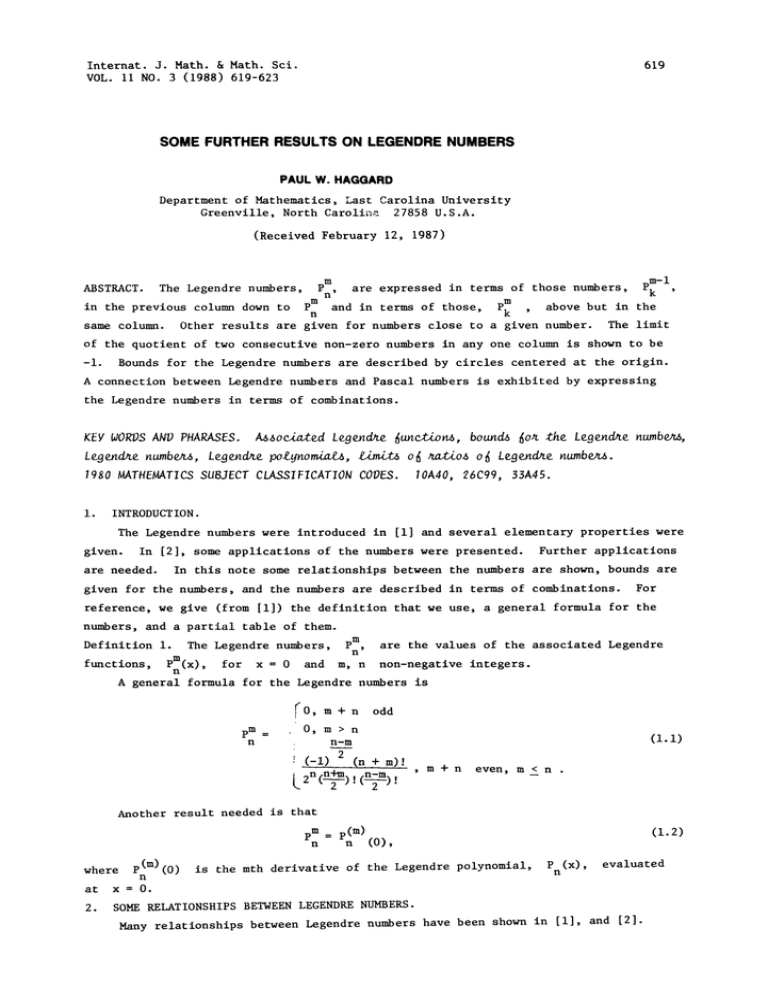
Internat. J. Math. & Math. Sci. VOL. ii NO. 3 (1988) 619-623 619 SOME FURTHER RESULTS ON LEGENDRE NUMBERS PAUL W. HAGGARD Department of Mathematics, Last Carolina University Greenville, North Carolina 27858 U.S.A. (Received February 12, 1987) ABSTRACT. pmn The Legendre numbers in the previous column down to Pmn are expressed in terms of those numbers and in terms of those, m Pk above but in the Other results are given for numbers close to a given number. same column. m-i Pk The limit of the quotient of two consecutive non-zero numbers in any one column is shown to be Bounds for the Legendre numbers are described by circles centered at the origin. -i. A connection between Legendre numbers and Pascal numbers is exhibited by expressing the Legendre numbers in terms of combinations. KEY WORDS AND PHARASES. Associated Legendre funns, bounds for the Legendre numbs, Legendre numbers, Legendre lynomi, limits of ratios of Legendre numbers. 1980 MATHEMATICS SUBJECT CLASSIFICATION CODES. 10A40, 26C99, 33A45. i. INTRODUCT ION. The Legendre numbers were introduced in [i] and several elementary properties were given. In [2], some applications of the numbers were presented. Further applications In this note some relationships between the numbers are shown, bounds are given for the numbers, and the numbers are described in terms of combinations. For reference, we give (from [i]) the definition that we use, a general formula for the are needed. numbers, and a partial table of them. Definition i. functions pm The Legendre numbers, pm(x) n for x 0 n’ and m, n are the values of the associated Legendre non-negative integers. A general formula for the Legendre numbers is [’0, pro= m + n odd O, m>n n (-i) n-m 2 .(n (i.i) .+ m)! L 2n(-) (-) m + n even, m < n Another result needed is that emn where at 2. p(m) (0) n x=0. p(m) n (1.2) (0), is the ruth derivative of the Legendre polynomial, P (x), n evaluated SOME RELATIONSHIPS BETWEEN LEGENDRE NUMBERS. Many relationships between Legendre numbers have been shown in [i], and [2]. 620 P.W. HAGGARD the preterms of the non-zero entries in Here, each Legendre number is expressed in is expressed entry in two ways. Further, each vious colum (see Table 1) dow to this entry. the same column but above in terms of the non-zero entries in the pn ’. n p n =p0 n n p2 pl p4 p3 p5 n n n n p7n p6 n n p8 n 0 - -3 0 15 15 0 15 8 0 105 0 48 0 _i0.__.5 105 384 0 105 0 105 2 0 945 945 0 0 945 0 -9454- - 0 10,8_395 48 TABLE i. 8 10,395 0 0 135 135 2 0 _135,1352 02,027,025 LEGENDRE NUMBERS From the known result, see [3], Z P’n(X) where n is n (2n- 4k + 3)Pn_2k+l(X k=l is even and n+l n ---if (2,1) odd, it follows that by taking m- i is derivatives then using (1.2), one has pm n-___l =n This gives each Legendre number, (2n- 4k + k=l m-i 3)Pn_2k+l, m, n _> i (2.2) m Pn’ as a sum of products involving the Legendre numbers in the preceeding column of Table i and above Other such formulas are n possible. Four that can be proved (mathematical induction, inducting on n is one way) are: 2n p2m+l 2n+l p2m 2n 2n+l pm. (-l)n-m(4m-l) (2.3) V2k-i k=m n Z P2k2m (-I )n-m (4m + i) (2.4) k--m (-i)n-.m.. (4m+l.)n. i 2 (n-m) k"m 2(n-m) 2m P2k k=m n > m Y2k+l n > m. (2.5) (2.6) Noe that (2.3) and (2.4) give each Legendre number as a product that involves the sum of the absolute values of the entries in the previous column and above the entry of Table I specified. Similarly, (2.5) and (2.6) involve the entries in the same 621 RESULTS ON LEGENDRE NUMBERS Equations (2.4) and (2.6) can be obtained from (2.3) and i. In fact, (2.5), repectively, by replacing 2n with 2n + i and 2m with 2m + (2.3) and (2.4) can be comblned as column but above the entry. pm (-i) n 2(2m-i) while (2.5) and (2.6) can be combined n-___m (-i) Pmn for m and n Pn-2k+l k= I 2 n-m as n-m (2ml)T lPm (2.8) n-2k k=l of the same parity. There are several results concerning entries in Table 1 that are near each other. These can be easily proved using properties of Legendre numbers or by using (1.1). For example, pm pm+l n-i m+l + Pn+l n > m 2m+ i n + 2 (2 9) gives each entry in terms of the entries in the next column and just above and below. Each entry in terms of the entries in the previous column and just above and below is given by pm (n+m-l) (n-m+2) pmn Considering m-i (pm-i + Pn+l )’ n-i 2m- 3 n (2.10) n, m > i. and the nearest entries on slant lines through pmn leads to a deter- minant type result, 2 (2n+l) m+l m-i m-i m+l Pn-iPn+l Pn-iPn+l (n+m-l) (n-m+2) (Pm)n 2 (2.11) Next, if we look at a particular non-zero entry and consider the first four nonzero entries above, below, to the left, and to the right, we have m m n n nP-2Pn+2- pm-2pm+2 left below which one can express as above _> 4, n 0, 2 _< m_< (2.12) n- 2 right. In [i], it was shown that the sum of the non-zero entries in any column of Table i converges. The limit of the ratio of consecutive entries is somewhat surprising. Choose the mth column of Table I. pmn+2 pmn For n + even and using (i.i), we have m i n+m+l n-m+2 Therefore, lim n- pm n+2 pm + _mn +-ni i ratios is i. m > i. (2.13) +2 n (2.14) i n From (2.13) it is clear that the limit approaches from the left for m n -i from the right for m 0 It is clear that the limit of the absolute value of the and P.W. HAGGARD 622 3. BOUNDS FOR THE LEGENDRE NUMBERS. From the known bound from [3], i P (x) < n for the Legendre polynomials, Pn(X), C with D /’ 2n D 0 x (3.2) ,/C is the circumference of a circle of radius 2n 2n one has, for /2n n where (3.1) .2n(l-x) n centered at the origin the diameter of the circle. In [i], the relationship pmn was given where P n-m the more general result Iemln < Using (3.2) in (3.3) we have is in the first column of Table i. (n+m-l) (n+m-3)-." (n-m+3) (n-re+l)/ -, m > i, n 2(n-m) is the circumference of a circle of radius 2(n-m) the diameter of the circle. origin with D 4. LEGENDRE NUMBERS IN TERMS OF COMBINATIONS. where (3.3) (n+m-l) (n+m-3)-.. (n-m+3) (n-m+l)Pn m’ m > 1 C n (3.4) >m, m centered at the In [2], combinations were expressed in terms of the Legendre numbers. express the Legendre numbers as combinations. C(q,i) Here, we The equation i 0 (4.1) q to i)!Pqq (q from [2] becomes (-i) n+m n-m 2 m! pm= - after solving for n+m n-m i and en+m2 (, __nm) C 2 n (-)1 p + q. then letting Since pn 2 q n (4.2) n-m 2 + i and 1.3.5.-.(2n-i), n m q i. Notice that see [i], n+m p 2 n+m 1-3"5’’’ (n+m-l) 2 (n + m) (4.3) n+m 2 2 n+m (---/--) Substituting (4.3) into (4.2) gives pm n (-!) n-m 2 ml(n+m)! 2n[(-)!]2 C (.nm, nm) (4.4) RESULTS ON LEGENDRE NUMBERS for n > 0, m and are given in [i] as n 0 P0 of the same parity, and m < n. pmn and i and 0 for m 623 The remaining values of n pmn of different parity. REFERENCES i. HAGGARD, P.W. 2. HAGGARD, P.W. 3. RAINVILLE, E.D. Special Functions, The Macmillan Company, New York, 1960. COPSON, E.T. An Introduction to the Theory of Functions of a Complex Variable, Oxford University Press, London, 1935. 4. 5. On Legendre Numbers, International Journal of Mathematics and Mathematical Sciences, Volume 8, No. 2 (1985) 407-411. Some Applications of Legendre Numbers, International Journal of Mathematics and Mathematical Sciences, (to appear). RICHARDSON, C.H. An Introduction to the Calculus of Finite Differences, C. Van Nostrand Company, Inc., New York, 1954.
